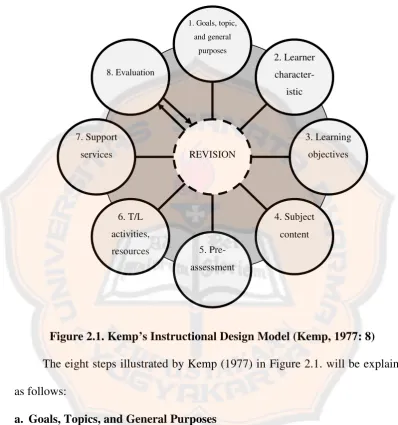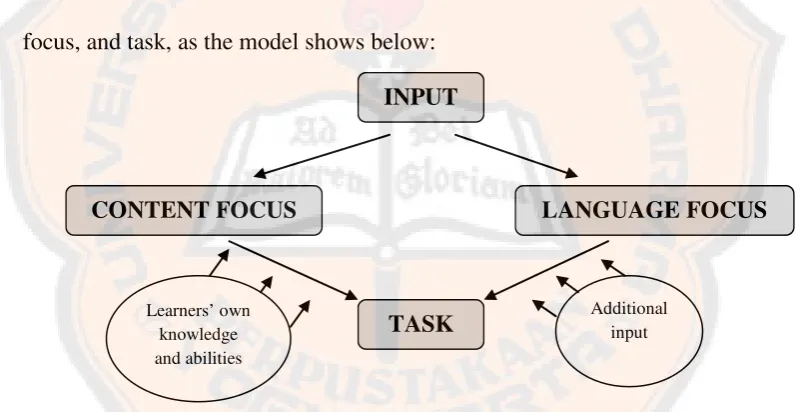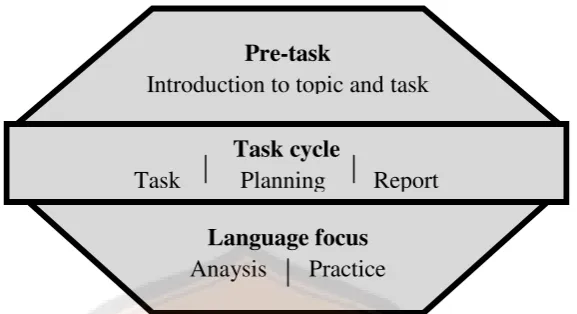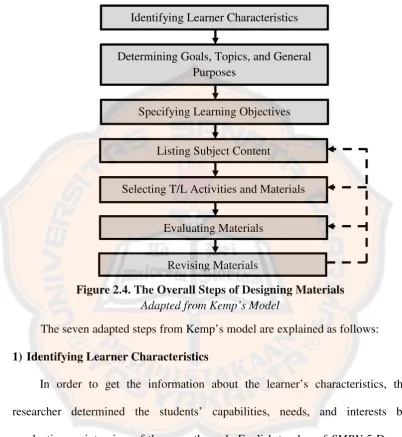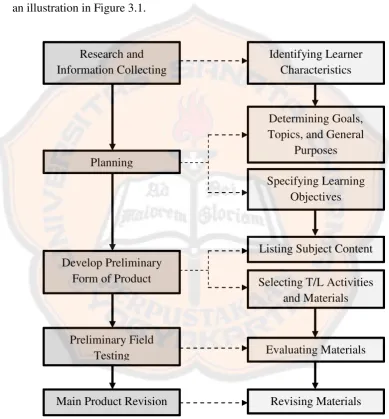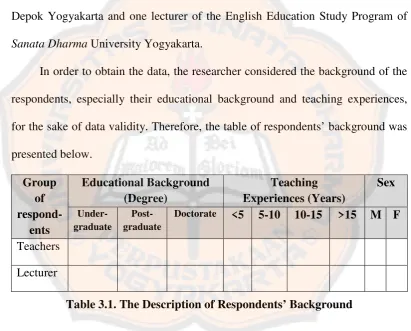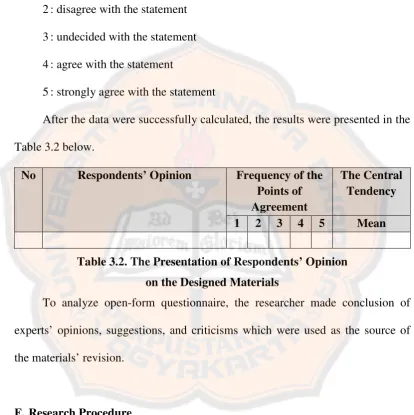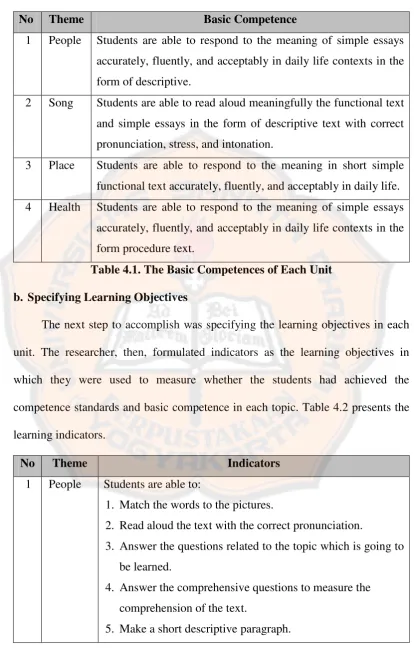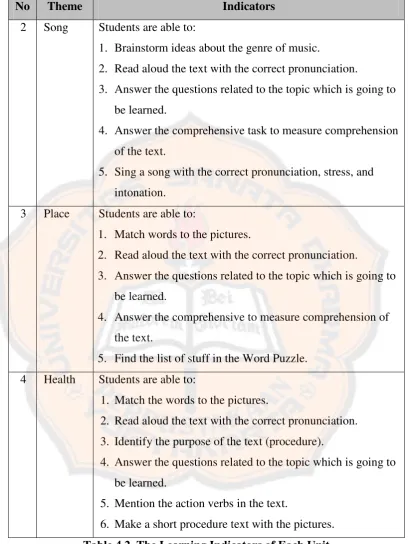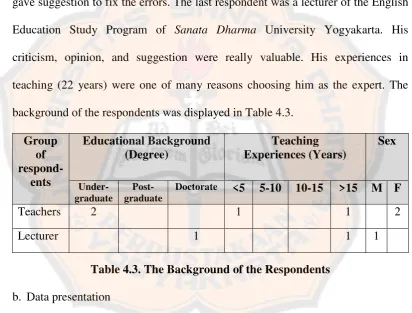A SET OF ENGLISH READING MATERIALS USING ENGLISH
TEEN MAGAZINES FOR THE SEVENTH GRADE STUDENTS
OF SMPN 5 DEPOK SLEMAN YOGYAKARTA
A SARJANA PENDIDIKAN THESIS
Presented as Partial Fulfillment of the Requirements to Obtain the Sarjana Pendidikan Degree
in English Language Education
By Ajeng Sawitri
Student Number: 071214052
ENGLISH LANGUAGE EDUCATION STUDY PROGRAM DEPARTMENT OF LANGUAGE AND ARTS EDUCATION FACULTY OF TEACHERS TRAINING AND EDUCATION
SANATA DHARMA UNIVERSITY YOGYAKARTA
i
A SET OF ENGLISH READING MATERIALS USING ENGLISH
TEEN MAGAZINES FOR THE SEVENTH GRADE STUDENTS
OF SMPN 5 DEPOK SLEMAN YOGYAKARTA
A SARJANA PENDIDIKAN THESIS
Presented as Partial Fulfillment of the Requirements to Obtain the Sarjana Pendidikan Degree
in English Language Education
By Ajeng Sawitri
Student Number: 071214052
ENGLISH LANGUAGE EDUCATION STUDY PROGRAM DEPARTMENT OF LANGUAGE AND ARTS EDUCATION FACULTY OF TEACHERS TRAINING AND EDUCATION
SANATA DHARMA UNIVERSITY YOGYAKARTA
vi
ABSTRACT
Sawitri, Ajeng. 2012. A Set of English Reading Materials Using English Teen Magazines for the Seventh Grade Students of SMPN 5 Depok Sleman Yogyakarta. Yogyakarta: English Language Education Study Program, Department of Language and Arts Education, Faculty of Teachers Training and Education, Sanata Dharma University.
Using English teen magazines is one of methods in getting students’ attention toward their reading activities in class. English teen magazines contain articles which are appropriate and fit with students’ personality. The researcher intends to develop more interesting reading materials by using articles existed in English teen magazines. Therefore, the students will find a new and enjoyable way of learning.
This research aims to answer the two questions: (1) How is a set of English reading materials using English teen magazines for the seventh grade students of SMPN 5 Depok Sleman Yogyakarta designed? and (2) What do the designed materials look like? To answer those questions, this research employed five steps of Educational Research and Development (R&D) cycle. Those steps were (1) Research and Information Collecting, (2) Planning, (3) Develop Preliminary Form of Product, (4) Preliminary Field Testing, and (5) Main Product Revision.
To answer the first question, the researcher adapted the instructional design model offered by Kemp. There were seven steps to design the materials, namely: (1) Identifying learner characteristics, (2) Determining goals, topics, and general purposes, (3) Specifying learning objectives, (4) Listing subject content, (5) Selecting teaching-learning activities and materials, (6) Evaluating materials, and (7) Revising materials. Meanwhile, the presentation of the designed materials as the answer of the second question can be seen in Appendix G. The designed materials consist of five sections, namely “Let’s Start!”, “Let’s Read!”, “Let’s Focus in Reading!”, “Let’s Focus in Language!”, and “Let’s End the Journey!”.
The result of the evaluation questionnaires indicated that the designed materials were good and acceptable. It was proven as they mostly chose scales point 4 from the scale of 1 to 5. It could be concluded that most of respondents agreed that the designed materials were applicable and appropriate to be implemented. The evaluation was then employed as the basis for revisions.
Upon the completion of this research, the researcher hopes that the designed materials will be useful for seventh grade English teachers to improve their students’ reading skills. Besides, the researcher also expects that the designed materials will inspire other researchers to conduct any further research related to the topic of this research.
vii
ABSTRAK
Sawitri, Ajeng. 2012. A Set of English Reading Materials Using English Teen Magazines for the Seventh Grade Students of SMPN 5 Depok Sleman Yogyakarta. Yogyakarta: Program Studi Pendidikan Bahasa Inggris, Jurusan Pendidikan Bahasa dan Seni, Fakultas Keguruan dan Ilmu Pendidikan, Universitas Sanata Dharma.
Menggunakan majalah remaja berbahasa Inggris adalah salah satu metode dalam mendapatkan perhatian siswa pada kegiatan reading di kelas. Majalah remaja berbahasa Inggris berisi artikel yang sesuai dan cocok dengan kepribadian siswa. Peneliti bertujuan untuk menciptakan materi reading yang lebih menarik dengan menggunakan artikel yang terdapat di dalam majalah remaja berbahasa Inggris. Dengan begitu, siswa akan menemukan cara belajar yang baru dan menyenangkan.
Penelitian ini bertujuan untuk menjawab dua pertanyaan: (1) Bagaimana seperangkat materi reading menggunakan majalah remaja berbahasa Inggris bagi siswa-siswi kelas VII SMPN 5 Depok Sleman Yogyakarta dibuat dan (2) Seperti apa bentuk materi yang dirancang tersebut. Untuk menjawab dua pertanyaan tersebut, penelitian ini menggunakan lima langkah dalam siklus Research and Development (R&D). Langkah tersebut antara lain: (1) Pengumpulan informasi, (2) Perencanaan, (3) Pengembangan bentuk awal produk, (4) Pengujian produk, dan (5) Revisi produk.
Untuk menjawab pertanyaan pertama, peneliti mengadaptasi model instruksional dari Kemp. Terdapat tujuh langkah untuk mendesain material, yaitu: (1) Mengidentifikasi karakteristik siswa, (2) Menentukan tujuan, topik, dan tujuan umum, (3) merumuskan tujuan pembelajaran, (4) Memilih isi pembelajaran, (5) Memilih kegiatan belajar-mengajar dan materi, (6) Mengevaluasi materi, dan (7) Merevisi materi. Sementara itu, presentasi dari materi yang menjadi jawaban dari pertanyaan kedua dapat dilihat pada Lampiran I. Disain materi tersebut terdiri dari lima bagian, yaitu “Let’s Start!”, “Let’s Read!”, “Let’s Focus in Reading!”, “Let’s Focus in Language!”, and “Let’s End the Journey!”.
Hasil dari kuesioner evaluasi dengan jumlah keseluruhan mode 4 mengindikasi bahwa desain materi baik dan diterima. Dapat disimpulkan bahwa para responden setuju materi yang didesain dapat diaplikasikan dan sesuai untuk diterapkan. Evaluasi kemudian digunakan sebagai acuan untuk perevisian materi.
Dengan selesainya penelitian ini, peneliti berharap agar materi yg telah didisain akan berguna bagi guru bahasa Inggris kelas VII untuk meningkatkan kemampuan reading siswa-siswi mereka. Di samping itu, peneliti juga berharap materi ini akan menginspirasi peneliti lain untuk melakukan penelitian lebih lanjut mengenai topik dalam penelitian ini.
viii
DEDICATION PAGE
This thesis is dedicated to
Imunkku (my QUEEN, my MOM)
ix
ACKNOWLEDGEMENTS
First and foremost, I would like to dedicate my gratitude to my glorious Jesus for His blessings and guidance so that I was able to finish my thesis. All my steps that I chose were based on His plan. He is my savior.
My biggest gratitude goes to Ibu Caecilia Tutyandari, S.Pd., M.Pd., my thesis advisor, for giving much of her time, attention, guidance, patient, support, criticism, comments and everything she has given for the sake of my success in finishing this thesis. My gratitude also goes to Bapak Drs. Barli Bram, M.Ed, Ph.D. for willingly spending his time evaluating my thesis and designed materials. Moreover, I am also grateful to all the lecturers and the secretariat staffs of English Education Study Program of Sanata Dharma University, especially Mbak Danik and Mbak Tari for their countless help during my study, and all librarians who assisted me during the completion of the study.
x
My big love and appreciation goes to my dad, Joko Riyatno, my mom,
Endang Sutarti, my big brother, Riko Iswara, and my little brother, Oktasadewa Putra Sasmita.I thank them for always being my side. Without them, I am nothing and alone. My love also goes to Nikolaus Primawan Aji Persada. Thanks for the companionship, commitment, and love. My affection also goes to our family dogs,
Gibson and Melross. They truly color my days with laughter and love in this family. My appreciation also goes to my big family, Bu Susatyaningsih, Om Tono Sasmita, Dek Dhamastya Papang Sasmita, Kak Gitta Angelina Wunas, and Tika Permita. I also address my thanks to my beloved teachers of ICEE from Philippines who now become my sisters, Ms. Meliza Entienza Satingasin and Ms. Jullieta. I also feel thankful to all my best friends ever, Roreta Natalia, Anmaria Redy,
Natasya Rizki, Agnesia Febriani, Gabriella Gaby Novianty, and Bezaliel Aditya. Thanks a bunch for the support, attention, and pray. Their prayer has already been answered by God through the success of this final work.
I would like to thank all my friends from English Education Study Program, especially to Wiwid Unyu, Eboy, and Ocha. Thanks for the support, help, and information so that I can finally finish this thesis. It means a lot to me. Thanks a million, girls!
Last but not least, I would like to thank every single person who I can not mention one by one. Once again, thanks!
xi
TABLE OF CONTENTS
Page
TITLE PAGE...i
APPROVAL PAGES... ii
STATEMENT OF WORK’S ORIGINALITY... iv
PERNYATAAN PERSETUJUAN PUBLIKASI... v
ABSTRACT... vi
LIST OF APPENDICES... xvi
CHAPTER I: INTRODUCTION
F. Definition of Terms... 5
CHAPTER II: REVIEW OF RELATED LITERATURE A. Theoretical Description...7
1. Instructional Design Models... 7
2. Reading... 11
a. The Definition of Reading... 11
xii
c. Teaching Reading... 14
3. Authentic Material... 14
a. Definition of Authentic Materials... 15
b. Advantages of Authentic Materials...15
c. Disadvantages of Authentic Materials... 16
4. Teen Magazines... 17
5. Materials Development... 19
6. Task-Based Learning (TBL)... 20
B. Theoretical Framework... 22
CHAPTER 3: RESEARCH METHODOLOGY A. Research Method... 26
1. Research and Information Collecting... 28
2. Planning... 28
3. Develop Preliminary Form of Product... 29
4. Preliminary Field Testing... 29
5. Main Product Revision... 29
B. Research Setting... 30
C. Research Participants... 30
1. Participants of Research and Information Collecting... 30
2. Participants of Materials Evaluation... 31
D. Instruments and Data Gathering Techniques...31
1. Instruments... 32
a. Questionnaire... 32
b. Interview... 33
2. Data Gathering Techniques... 33
E. Data Analysis Technique... 34
1. Analyzing Data in Research and Information Collecting... 34
xiii
F. Research Procedure... 35
CHAPTER IV: RESEARCH RESULTS AND DISCUSSION A. The Steps in Designing Materials... 37
1. Research and Information Collecting... 37
2. Planning... 41
a. Determining Goals, Topics, and General Purposes...41
b. Specifying Learning Objectives... 42
3. Develop Preliminary Form of Product... 44
a. Listing Subject Contents... 44
b. Selecting T/L Activities and Materials... 46
4. Preliminary Field Testing... 46
5. Main Product Revision... 51
B. The Presentation of the Designed Materials... 52
CHAPTER V: CONCLUSIONS AND RECOMMENDATIONS A. Conclusions... 53
B. Recommendations... 54
REFERENCES... 55
xiv
LIST OF TABLES
Table Page
3.1 The Description of Respondents’ Background... 31
3.2 The Presentation of Respondents’ Opinion on the Designed Materials...35
4.1 The Basic Competences of Each Unit... 42
4.2 The Learning Indicators of Each Unit... 42
4.3 The Background of the Respondents... 47
xv
LIST OF FIGURES
Figure Page
2.1 Kemp’s Instructional Design Model...8
2.2 Hutchinson and Waters’ Materials Design Model... 19
2.3 Willis’ Task-based Learning Framework... 21
2.4 The Overall Steps of Designing Materials... 24
xvi
LIST OF APPENDICES
Appendix Page
A. The Permission Letter... 58
B. The Interview Checklist for Research and Information Collecting... 60
C. The Questionnaire for Research and Information Collecting... 62
D. The Questionnaire for Materials Evaluation... 64
E. The Syllabus of the Designed Materials... 68
F. The Lesson Plans of the Designed Materials... 73
vi ABSTRACT
Sawitri, Ajeng. 2012. A Set of English Reading Materials Using English Teen Magazines for the Seventh Grade Students of SMPN 5 Depok Sleman Yogyakarta. Yogyakarta: English Language Education Study Program, Department of Language and Arts Education, Faculty of Teachers Training and Education, Sanata Dharma University.
Using English teen magazines is one of methods in getting students’ attention toward their reading activities in class. English teen magazines contain articles which are appropriate and fit with students’ personality. The researcher intends to develop more interesting reading materials by using articles existed in English teen magazines. Therefore, the students will find a new and enjoyable way of learning.
This research aims to answer the two questions: (1) How is a set of English reading materials using English teen magazines for the seventh grade students of SMPN 5 Depok Sleman Yogyakarta designed? and (2) What do the designed materials look like? To answer those questions, this research employed five steps of Educational Research and Development (R&D) cycle. Those steps were (1) Research and Information Collecting, (2) Planning, (3) Develop Preliminary Form of Product, (4) Preliminary Field Testing, and (5) Main Product Revision.
To answer the first question, the researcher adapted the instructional design model offered by Kemp. There were seven steps to design the materials, namely: (1) Identifying learner characteristics, (2) Determining goals, topics, and general purposes, (3) Specifying learning objectives, (4) Listing subject content, (5) Selecting teaching-learning activities and materials, (6) Evaluating materials, and (7) Revising materials. Meanwhile, the presentation of the designed materials as the answer of the second question can be seen in Appendix G. The designed materials consist of five sections, namely “Let’s Start!”, “Let’s Read!”, “Let’s Focus in Reading!”, “Let’s Focus in Language!”, and “Let’s End the Journey!”.
The result of the evaluation questionnaires indicated that the designed materials were good and acceptable. It was proven as they mostly chose scales point 4 from the scale of 1 to 5. It could be concluded that most of respondents agreed that the designed materials were applicable and appropriate to be implemented. The evaluation was then employed as the basis for revisions.
Upon the completion of this research, the researcher hopes that the designed materials will be useful for seventh grade English teachers to improve their students’ reading skills. Besides, the researcher also expects that the designed materials will inspire other researchers to conduct any further research related to the topic of this research.
vii ABSTRAK
Sawitri, Ajeng. 2012. A Set of English Reading Materials Using English Teen Magazines for the Seventh Grade Students of SMPN 5 Depok Sleman Yogyakarta. Yogyakarta: Program Studi Pendidikan Bahasa Inggris, Jurusan Pendidikan Bahasa dan Seni, Fakultas Keguruan dan Ilmu Pendidikan, Universitas Sanata Dharma.
Menggunakan majalah remaja berbahasa Inggris adalah salah satu metode dalam mendapatkan perhatian siswa pada kegiatan reading di kelas. Majalah remaja berbahasa Inggris berisi artikel yang sesuai dan cocok dengan kepribadian siswa. Peneliti bertujuan untuk menciptakan materi reading yang lebih menarik dengan menggunakan artikel yang terdapat di dalam majalah remaja berbahasa Inggris. Dengan begitu, siswa akan menemukan cara belajar yang baru dan menyenangkan.
Penelitian ini bertujuan untuk menjawab dua pertanyaan: (1) Bagaimana seperangkat materi reading menggunakan majalah remaja berbahasa Inggris bagi siswa-siswi kelas VII SMPN 5 Depok Sleman Yogyakarta dibuat dan (2) Seperti apa bentuk materi yang dirancang tersebut. Untuk menjawab dua pertanyaan tersebut, penelitian ini menggunakan lima langkah dalam siklus Research and Development (R&D). Langkah tersebut antara lain: (1) Pengumpulan informasi, (2) Perencanaan, (3) Pengembangan bentuk awal produk, (4) Pengujian produk, dan (5) Revisi produk.
Untuk menjawab pertanyaan pertama, peneliti mengadaptasi model instruksional dari Kemp. Terdapat tujuh langkah untuk mendesain material, yaitu: (1) Mengidentifikasi karakteristik siswa, (2) Menentukan tujuan, topik, dan tujuan umum, (3) merumuskan tujuan pembelajaran, (4) Memilih isi pembelajaran, (5) Memilih kegiatan belajar-mengajar dan materi, (6) Mengevaluasi materi, dan (7) Merevisi materi. Sementara itu, presentasi dari materi yang menjadi jawaban dari pertanyaan kedua dapat dilihat pada Lampiran I. Disain materi tersebut terdiri dari lima bagian, yaitu “Let’s Start!”, “Let’s Read!”, “Let’s Focus in Reading!”, “Let’s Focus in Language!”, and “Let’s End the Journey!”.
Hasil dari kuesioner evaluasi dengan jumlah keseluruhan mode 4 mengindikasi bahwa desain materi baik dan diterima. Dapat disimpulkan bahwa para responden setuju materi yang didesain dapat diaplikasikan dan sesuai untuk diterapkan. Evaluasi kemudian digunakan sebagai acuan untuk perevisian materi.
Dengan selesainya penelitian ini, peneliti berharap agar materi yg telah didisain akan berguna bagi guru bahasa Inggris kelas VII untuk meningkatkan kemampuan reading siswa-siswi mereka. Di samping itu, peneliti juga berharap materi ini akan menginspirasi peneliti lain untuk melakukan penelitian lebih lanjut mengenai topik dalam penelitian ini.
viii
DEDICATION PAGE
This thesis is dedicated to Imunkku (my QUEEN, my MOM)
ix
ACKNOWLEDGEMENTS
First and foremost, I would like to dedicate my gratitude to my glorious Jesus for His blessings and guidance so that I was able to finish my thesis. All my steps that I chose were based on His plan. He is my savior.
My biggest gratitude goes to Ibu Caecilia Tutyandari, S.Pd., M.Pd., my thesis advisor, for giving much of her time, attention, guidance, patient, support, criticism, comments and everything she has given for the sake of my success in finishing this thesis. My gratitude also goes to Bapak Drs. Barli Bram, M.Ed, Ph.D. for willingly spending his time evaluating my thesis and designed materials. Moreover, I am also grateful to all the lecturers and the secretariat staffs of English Education Study Program of Sanata Dharma University, especially Mbak Danik and Mbak Tari for their countless help during my study, and all librarians who assisted me during the completion of the study.
x
My big love and appreciation goes to my dad, Joko Riyatno, my mom, Endang Sutarti, my big brother, Riko Iswara, and my little brother, Oktasadewa
Putra Sasmita. I thank them for always being my side. Without them, I am nothing
and alone. My love also goes to Nikolaus Primawan Aji Persada. Thanks for the companionship, commitment, and love. My affection also goes to our family dogs, Gibson and Melross. They truly color my days with laughter and love in this family.
My appreciation also goes to my big family, Bu Susatyaningsih, Om Tono Sasmita, Dek Dhamastya Papang Sasmita, Kak Gitta Angelina Wunas, and Tika
Permita. I also address my thanks to my beloved teachers of ICEE from Philippines
who now become my sisters, Ms. Meliza Entienza Satingasin and Ms. Jullieta. I also feel thankful to all my best friends ever, Roreta Natalia, Anmaria Redy, Natasya Rizki, Agnesia Febriani, Gabriella Gaby Novianty, and Bezaliel Aditya.
Thanks a bunch for the support, attention, and pray. Their prayer has already been answered by God through the success of this final work.
I would like to thank all my friends from English Education Study Program, especially to Wiwid Unyu, Eboy, and Ocha. Thanks for the support, help, and information so that I can finally finish this thesis. It means a lot to me. Thanks a million, girls!
Last but not least, I would like to thank every single person who I can not mention one by one. Once again, thanks!
xi
TABLE OF CONTENTS
Page TITLE PAGE...i APPROVAL PAGES... ii STATEMENT OF WORK’S ORIGINALITY... iv PERNYATAAN PERSETUJUAN PUBLIKASI... v ABSTRACT... vi LIST OF APPENDICES... xvi
CHAPTER I: INTRODUCTION F. Definition of Terms... 5
CHAPTER II: REVIEW OF RELATED LITERATURE
A. Theoretical Description...7 1. Instructional Design Models... 7 2. Reading... 11
xii
c. Teaching Reading... 14 3. Authentic Material... 14 a. Definition of Authentic Materials... 15 b. Advantages of Authentic Materials...15 c. Disadvantages of Authentic Materials... 16 4. Teen Magazines... 17 5. Materials Development... 19 6. Task-Based Learning (TBL)... 20 B. Theoretical Framework... 22
CHAPTER 3: RESEARCH METHODOLOGY
xiii
F. Research Procedure... 35
CHAPTER IV: RESEARCH RESULTS AND DISCUSSION
A. The Steps in Designing Materials... 37 1. Research and Information Collecting... 37 2. Planning... 41 a. Determining Goals, Topics, and General Purposes...41 b. Specifying Learning Objectives... 42 3. Develop Preliminary Form of Product... 44 a. Listing Subject Contents... 44 b. Selecting T/L Activities and Materials... 46 4. Preliminary Field Testing... 46 5. Main Product Revision... 51 B. The Presentation of the Designed Materials... 52
CHAPTER V: CONCLUSIONS AND RECOMMENDATIONS
A. Conclusions... 53 B. Recommendations... 54
REFERENCES... 55
xiv
LIST OF TABLES
Table Page
xv
LIST OF FIGURES
Figure Page
xvi
LIST OF APPENDICES
Appendix Page
CHAPTER I INTRODUCTION
This chapter aims to introduce the research background, research problem, problem limitation, research objectives, research benefits, and definitions of terms.
A.Research Background
Responding to the phenomenon that English has been the international language, many countries in the world, which do not use English as their first language, start to include English lesson as a compulsory subject in schools. Indonesia as one of those countries also does the same thing. The government adds English in the curriculum at elementary school levels up to university levels.
Since, the curriculum used in Indonesia is the Kurikulum Tingkat Satuan Pendidikan (KTSP) or School Based Curriculum. In this curriculum, every school is given an opportunity to develop and manage the curriculum based on its condition and aspiration (Muslich, 2007: 10). There are four skills in English lesson stated in the curriculum, one of them is reading.
Some observations in schools conducted by the researcher showed that reading sometimes made students feel bored and sleepy. In addition, the researcher also interviewed a teacher of SMPN 5 Depok Sleman Yogyakarta about the situation of reading classes in English subject in that school. The results of the interview show that reading classes often make the students bored when the materials are less interesting. Therefore, the researcher considers that materials which contain topic related to and appropriate for teens can enhance their reading competence and their interest in reading English texts.
In order to provide interesting and relevant materials, the researcher proposes the use of one kind of authentic material, English teen magazines. Berardo (2006) says that authentic materials are “materials that have been produced to fulfill some social purposes in the language community.” By designing materials using English teen magazines, they hopefully would know current events and be accustomed to reading English articles. English teen magazines not only contain articles that are easy and fun to read but also good layouts so that students will pay attention and be interested in it. “Students make greater strides forward in comprehending reading if they are reading topics that appeal to them personally” (McShane, 2005).
important for the seventh grade of SMPN 5 Depok Sleman Yogyakarta especially in the English class. The English teacher realizes that SMPN 5 Depok Sleman Yogyakarta students at seventh grade need many English reading materials since reading is their fundamental in learning English. It is also recognized that fun and modified reading material can improve students’ interest in reading English.
In conclusion, the researcher intends to develop more interesting reading materials. Therefore, the students will find a new and enjoyable way of learning. By using English teen magazines, the researcher develops reading materials which are in accordance with the students’ needs and interests. As a result, they would be accustomed to reading English articles.
B.Research Problems
The researcher formulates two problems which are to be discussed as follows. 1. How is a set of English reading materials using English teen magazines for the
seventh grade students of SMPN 5 Depok Yogyakarta designed? 2. What do the designed materials look like?
C.Problem Limitation
Second, the reading materials which are discussed in this research are only reading material based on English teen magazines, not other reading materials.
D.Research Objectives
In relation to the research problems above, this research aims to:
1. design a set of English reading materials using English teen magazines for the seventh grade students of SMPN 5 Depok Sleman Yogyakarta.
2. present the designed set of materials.
E.Research Benefits
The researcher expects this research to be beneficial to those who are concerned with education especially for:
1. English teachers
Teachers of the seventh grade students of junior high school may consider these set of reading instructional materials as one of the alternatives to help the students enhance their reading motivation and to develop their reading skill.
2. The seventh grade students of junior high school
3. Other material designers
The results of the research hopefully will provide beneficial information and may lead other material designers to produce a better result. They may consider that reading materials can be developed to be more attractive.
F. Definition of Terms
The definition of terms is very important to be known. In order to avoid misunderstanding or misinterpretation, the researcher specifies the terms.
1. Reading
There are many definitions of reading. Nuttal as cited by Simanjuntak (1998: 14) regards reading as “the meaningful interpretation of printed or written verbal symbols.” Neil Anderson as quoted by Nunan (2003: 68), defines reading as “a fluent process of readers combining information from a text and their own background knowledge to build meaning”. In this research, reading means an activity of interpreting and getting the information from the text in English teen magazine to enhance reading skill.
2. Teen Magazine
English teen magazine is designed for teenagers where they are the seventh grade students of SMPN 5 Depok Sleman Yogyakarta.
Lavery’s writing entitled “Activities for Using Magazines in the Classroom” in
British Council
CHAPTER II
REVIEW OF RELATED LITERATURE
This chapter presents related theories and studies used in this research as theoretical base for the research. There are two main parts; Theoretical Description and Theoretical Framework. Theoretical Description deals with instructional design, reading, authentic materials, teen magazines, materials development, and task-based learning (TBL). Meanwhile, the theoretical framework summarizes all major relevant theories to help the researcher solve the problems.
A.Theoretical Description
This part presents the main theories used as reference in this research. There are six sections to be discussed as follows.
1. Instructional Design Models
designing the material in this research. Figure 2.1 presents eight steps of Kemp’s instructional design model.
Figure 2.1. Kemp’s Instructional Design Model (Kemp, 1977: 8)
The eight steps illustrated by Kemp (1977) in Figure 2.1. will be explained as follows:
a. Goals, Topics, and General Purposes
The design begins with deciding the goals as the basis of the program where the goals are derived from three sources, namely society, students, and subject areas. Afterwards, the topics are selected to serve the goals. Finally, the general purposes of each topic are stated.
b. Learner Characteristics
The second step in Kemp’s model is identifying the characteristics of the learners for whom the instruction is to be designed to know their capabilities, needs, and interests. Those three characteristics can be guidance in selecting the topic and the level at which topics are introduced, the choice and sequencing of objectives, the depth of treatment, and the variety of learning activities.
c. Learning Objectives
This step is aimed to formulate the specific instructional objectives that should be achieved based on the observable and measurable students’ attitude. The learning objectives stated in instructional planning should be unambiguous, realistic, and clear so that it can be understood by both the writer and learners. The objective of learning can be grouped by three major categories, namely cognitive, psychomotor, and affective.
d. Subject Content
After specifying the learning objectives, the subject content which supports the attainment of each objective should be listed. In deciding subject contents, Kemp offers four questions: What specifically must be taught or learned in this topic? What facts, concepts, and principles related to the topic? What steps are involved in necessary produce relating to the topic? What techniques are required in performing essential skills?
e. Pre-Assessment
the topic. By pre-assessment, the designer can ensure whether the learner waste their time on things they have already mastered or not and also can measures the learners’ readiness in following the planned instruction.
f. Teaching/Learning Activities and Instructional Resources
In order to support subject content, selecting teaching/learning activities and instructional resources are needed so that the learners can accomplish each objective.
g. Support Services
To carry out the instructional planning, the designer should coordinate some support services such as budget/funds, personnel, facilities, equipment, and schedules. The determination of support services is done while the selection of materials is being done and the instructional planning is being designed.
h. Evaluation
The last step is conducting evaluation which is aimed to measure the learning outcomes related to objectives, with a view to revising and re-evaluating any phases of the plan that need improvement. The evaluation should be done to see whether the materials are successfully implemented and appropriate for the learners or not.
2. Reading
In order to know reading well, this part will be divided into some parts. There are three major part discussed: the definition of reading, reading purpose, and teaching reading.
a. The Definition of Reading
Before deciding on what kind of reading materials designed for students, it is essential to have a clear definition of what reading is. Gibson and Levin (1979: 5) state that reading is extracting information from a text. It means that text is not necessarily just printed words, it must be combined with pictures, diagrams, graphs, illustration, and etc.
As cited by Nunan (2003: 68), Anderson defines reading as “a fluent process of readers combining information from a text and their own background knowledge to build meaning.” It means that in reading, the reader does not only get the information from a text or printed words or written symbols but also combine the derived information with his background knowledge to get the meaning.
Clark and Silberstein (as mentioned by Simanjuntak, 1998: 15) define reading as “an active cognitive process of interacting with print and monitoring comprehension to establish meaning.” An active cognitive process means the ability to understand the passage. When the reader reads a passage, there is processing of information in his mind.
understand everything in the text. William (1986: 2) states that readers are not passive subjects who can only read letters, words, and sentences without understanding the content, but they are active subjects who are able to work on the text and able to come to the understanding without looking at every letter and word. In other words, readers are active subjects who can select and comprehend the information in the text.
To sum up, reading is a process where the readers, as active subjects, use their ability in getting the information from the text or printed words or written symbols which is usually combined with pictures, diagrams, or graphs and also they use their background knowledge to derive the meaning of the passage.
If readers, in this case students, are active subjects, teachers should know what reading materials their students want to read and what is suitable for the students’ level. As what is proposed by Davis (1997), teachers should constantly search for new and innovative materials to enhance learning in the formal class environment. Davis believes that other materials should be introduced into the class to expose students, both physically and mentally, to the outside world, particularly in EFL settings where authentic models are scarce. Therefore, in this design, the researcher would like to use English teen magazines as the main reading materials in order to develop students’ reading ability.
b. Reading Purpose
serve immediate needs, to learn from, or to give pleasure in language for its own sake (1992: 6). Wallace mentions those three reading purposes; they are reading for survival, reading for learning, and reading for pleasure.
In a more specific way, Wallace (1992: 65-69) shows the purposes of reading by looking at the learning context and the learners of a second language. It is classified into three kinds of purposes as written by Wallace. Those purposes are:
1) Reading for Specific Purposes
It is common that in the recent years, many students learn English for a very particular purpose and terms such as English for Specific Purposes (ESP) and English for Academic Purposes (EAP). As a result, they use reading activity in order to gain their knowledge to deal with their area of specialization.
2) Reading for General Purposes
The second language learners, whether they are ESP learners or not, will still need and want to be general readers. They probably read many kinds of textbooks with different topics.
3) Reading for Pleasure in the Second Language
c. Teaching Reading
This research adopted the principles for teaching reading from Nation (2009) which can guide the design and practice of a reading program. There are five important points:
1) Practice and training in reading should be done for a range of reading purposes, such as: reading to search for information, reading to learn, reading for fun, reading to integrate information, reading to critique texts, and reading to write. 2) Learners should be doing reading which is appropriate to their language
proficiency level.
3) Reading should be used as a way of developing language proficiency. Learners are expected to read with 98 percent coverage of the vocabulary in the text so that they can learn the remaining 2 percent through guessing from the context. 4) Learners should be given training and practice in a range of reading strategies
include previewing, predicting, connecting to background knowledge, paying attention to text structure, guessing words from context, critiquing, and reflecting on the text.
5) Learners should enjoy reading and feel motivated to read. Learners should have access to interesting texts and be involved in activities.
3. Authentic Materials
a. Definition of Authentic Materials
Berardo (2006) states that authentic materials should be suited to students’ need and enable them to interact with the real language and content so that they feel that they are learning the target language as it is used outside the classroom. He also adds that the sources of authentic materials that can be used in the classroom are infinite, but the most common are newspapers, magazines, movies, songs and literature.
The researcher supports what Berardo states and what Nunan (2003: 329) affirms that authentic texts should be taken from real situations and usage. In this research, authentic materials refer to materials which are designed to fulfill students’ need in reading and facilitate them with new sources from teen magazines. Teen magazines contain real situations so that students are supported to face the real language.
b. Advantages of Authentic Materials
Martinez (2002) encourages that “using authentic material in the classroom, even when not done in an authentic situation, is significant for many reasons.” Those reasons are:
1) Authentic materials keep students informed about what is happening in the world, so they have an intrinsic educational value.
2) Textbooks often do not include incidental or improper English.
4) Magazines, books, articles, and newspapers contain a wide variety of text types, language styles are not easily found in conventional teaching materials. By utilizing authentic materials, leaners are being exposed to ‘real’ language and they feel that they are learning the ‘real’ language.
5) Authentic materials can encourage reading for pleasure because they are likely to contain topics of interest to learners, especially if students are given the chance to have a say about the topics or kinds of authentic materials to be used in class. It supports a more creative approach in teaching.
c. Disadvantages of Authentic Materials
When preparing and using authentic materials for learners, it is inevitable that there might be some problems. There are three main problems taken from Berardo. The first problem is that authentic materials are updated quickly so that it needs special preparation, a lot of cost, and can be time consuming.
The second problem is authentic materials often contain difficult language, vocabularies, and language structures, which can often create problems for the teacher too.
The last and biggest problem with authentic materials is that if the wrong type of text is chosen, the vocabulary may not be relevant to the learners’ needs and too many structures can create difficulty and it can de-motivate rather than motivate learners.
authentic. Second, rather than simplifying the text, it can be made more approachable by eliciting students’ existing knowledge in pre-reading activity before they begin reading, such as reviewing new vocabulary before reading, skimming to get main idea, or scanning for specific information.
4. Teen Magazines
Based on Lavery’s (2009) argument, magazines are a rich source of authentic materials and can be very motivating and inspire a wide range of activities and also magazines are a great source of ideas and materials for teaching and can keep the students interested and talking for hours on a whole range of subjects.
In British Council website, Bertrand (2002) also presents the main points in using teen magazines in the classroom. He defines that teenage magazines generally have a few articles based on thought-provoking subjects which can really stimulate a class of teenagers. Through teen magazines, the students can be helped in facing the problem toward their reading interest. It is stated that with a set of different teenage magazines will let the students flick through them until they find an article which interests them. There are five points suggested in using teen magazines in reading English class that Bertrand lists, as follows:
1) The students should read the titles, look at the pictures, and skim the texts to get a general idea of what the article is.
3) If it is a large class then in groups of four the students can take it in turns to tell the others about their article. If the class is relatively small, the teacher can feedback in two groups or as a whole class.
By designing the materials using English teen magazines, it will stimulate the students’ interest in reading activity. There are three considerations in choosing English teen magazines as the basis in making the materials.
1) Daily words
Teen magazines apply words use in everyday language while textbooks use the formal one which is hard to apply in the daily life. By reading the passage from teen magazines, the students get the idea of what words are used in printed media.
2) Learners’ comprehension
The colorful layout and appealing format in teen magazines will capture the attention of students. It will increase their motivation if they are interested in the passages which contain something they like, for example a passage which contains information about a singer, like Justin Bieber, whom junior high school students like to know. Students’ motivation increases their level of comprehension in reading the passage.
3) The purpose of reading
competences from the curriculum, the English teen magazines are used as the source of the designed materials and they are combined with the various tasks. Therefore, the designed materials overall can be used as reading for general purpose in learning English.
5. Materials Development
To develop the materials designed, the researcher applied the principles from Hutchinson and Waters (1987: 108-109) in which the materials design model is figured clearly. There are four elements: input, content focus, language focus, and task, as the model shows below:
Figure 2.2. A Materials Design Model (Hutchinson and Waters, 1987: 109)
As seen in the model (Figure 2.3), the first element is input. Input works as the stimulus for activities that give opportunities for learners to use their information processing skills and existing knowledge, both in the language and in the subject matter. Input may be in the form of text, dialogue, video-recording, diagram or any piece of communication data, depending on needs analysis.
INPUT
CONTENT FOCUS
TASK
LANGUAGE FOCUS
Learners’ own knowledge and abilities
Input is divided into two elements, content focus and language focus. In the content focus, language is not an end in itself but a means of conveying information and feelings about something. The content should be explored to generate meaningful communication in the classroom. In the language focus, learners have the chance to put the language into analysis, study how it works, and practice it.
The last element is task. Task has a big role. It measures how far learners have used the content and language knowledge they have built up through the unit. Actually, task is the primary focus of the unit and the model is only a vehicle to lead the learners carry out the task.
6. Task-Based Learning (TBL)
Willis (2003: 40-41) states that task-based learning (TBL) emphasizes on learners do tasks independently but still guided by teacher. Teacher is generally a ‘facilitator’ in setting tasks up, ensuring that students understand and get on with the tasks, and sum up what students have achieved during a lesson. Teacher acts as a ‘course guide’ when explaining to students the overall objectives of the course and as a ‘language guide’ at the end of course when the focus turns to language form.
Figure 2.3. Task-based Learning Framework (Willis, 2003: 38)
It starts with pre-task. This phase introduces the class to the topic and the task. Teacher should help students recall and activate words or phrases that will be useful during the task.
The second phase is task cycle. There are three components in this phase: task, planning, and report. Firstly, the students are asked to do the task, in pairs or small groups. Here, teacher monitors and encourages the students. Then, in planning, students have a preparation time to report the result of the task to the whole class (orally or in writing). Teacher has a role to give feedback and help students to correct their work. And the last, teacher selects some groups to present their reports of the task to the class. As guide, teacher needs to revise and sum up their work.
The last phase in the framework, language focus, students will have already worked with the language and processed it for meaning. Teacher, as a ‘language guide’, encourage students to focus their attention on the specific language forms that carry that meaning.
Pre-task
Introduction to topic and task
Language focus
Anaysis Practice
Task cycle
B.Theoretical Framework
In this section, the researcher would like to summarize and synthesize all major relevant theories which will help in conducting and solving the research problems.
Reading is a skill which will support other skills, such as speaking, listening, and writing. For students’ significance, teachers should realize that reading must be developed since reading will enhance other skills. Students need to have more reading time to build their comprehension toward English, especially in an English subject.
Concerning the importance of reading for students, especially for junior high school students, this research aims to design reading materials which are modified by using English teen magazines. The designed materials propose to introduce new learning sources which are considered to meet students’ needs in gaining knowledge or information and pleasure in reading English article.
Using English teen magazines is one of methods in getting students’ attention toward their reading activities in class. English teen magazines contain articles which are appropriate and fit with students’ personality. English teen magazines use everyday language that will help them in having English conversation. The colorful layout and appealing format in English teen magazines also motivate students to read it. Therefore, the articles used for the materials designed are all taken from English teen magazines.
provide language styles that are not easily found in conventional teaching materials. By using English teen magazines, the students are being exposed to ‘real’ language. Even English teen magazines contain difficult language and vocabulary; it can be overcome by simplify the texts according to the students’ level by removing or switching some difficult words into easy ones without changing the meaning. Simplification can not be done to all difficult words in the texts since it will make the text “less” authentic.
Kathleen Graves (2000) confirms that “no book can meet all the needs and interests of each group of learners that uses it that is why a course book must be adapted” (as cited in Nunan, 2003: 230). For this statement, the researcher designs the materials as main reading materials to complete students’ needs toward their course book. To develop the materials designed, the researcher applied the principles from Hutchinson and Waters (1987: 108-109) which have four elements: input, content focus, language focus, and task. The principles of Task-Based Learning (TBL) from Willis (2003) also applied when the designed materials are implemented in the classroom. Willis (2003: 38-115) has three phases as the components of the TBL framework: pre-task, task cycle, and language focus.
and suitable for this research. There are eight steps in Kemp’s model. The researcher arranges six adapted steps that can be clearly seen in the Figure 2.5.
Figure 2.4. The Overall Steps of Designing Materials
Adapted from Kemp’s Model
The seven adapted steps from Kemp’s model are explained as follows:
1) Identifying Learner Characteristics
In order to get the information about the learner’s characteristics, the researcher determined the students’ capabilities, needs, and interests by conducting an interview of the seventh grade English teacher of SMPN 5 Depok Sleman Yogyakarta and distributing questionnaire to two classes of seventh grade students of SMPN 5 Depok Sleman Yogyakarta. The results were used as guidance in designing the materials.
Identifying Learner Characteristics
Specifying Learning Objectives Determining Goals, Topics, and General
Purposes
Listing Subject Content
Selecting T/L Activities and Materials Evaluating Materials
2) Determining Goals, Topics, and General Purposes
The next step is listing the goal as the basis for designing reading materials. After recognizing and establishing the goals, the major topic should be listed. After all, the researcher determines the general purpose of each topic.
3) Specifying Learning Objectives
The specific learning objectives are formulated after goals, topic, and general purposes are determined. It is important to know the teacher’s expectation on the students with the things that they have been instructed.
4) Listing Subject Content
In this step, the researcher lists subject content to help the students in achieving objectives.
5) Selecting Teaching Learning Activities and Materials
This step is conducted to select the appropriate teaching learning activities. The selection of teaching-learning activities should fit with the students’ needs of which the data had been already taken from the first step.
6) Evaluating Materials
The evaluation can be done by distributing the questionnaires to the selected experts. It is used to improve the designed materials.
7) Revising Materials
CHAPTER III
RESEARCH METHODOLOGY
This chapter contains the information about the methodology of the research. There are six parts discussed: research methods, research setting, research participants, instruments and data gathering technique, data analysis technique, and research procedure.
A.Research Method
In this research, there were two main problems stated in problem formulation. Firstly, this research was conducted to find out how a set of English reading materials using English teen magazines for the seventh grade students of
SMPN 5 Depok Sleman Yogyakarta is designed. Secondly, the research aimed to present the designed set of English reading materials using English teen magazines for the seventh grade students of SMPN 5 Depok Sleman Yogyakarta.
dissemination and implementation. However, the researcher used only the first five steps of the method.
To give a clear relation between R&D cycle and step in designing materials which were adapted from Kemp’s instructional design model, the researcher made an illustration in Figure 3.1.
1. Research and Information Collecting
In research and information collecting step, two ways were conducted: review of literature and learners’ needs analysis.
a. In reviewing the literature, the researcher conducted library research. It included an overall narrative description of the proposed product, a tentative outline of what the product will include and how it will be used, and a specific statement of the objectives of the product (Borg and Gall, 1983: 776). Review of literature helped the researcher solve the research problems by ensuring all major relevant theories.
b. The learners’ needs analysis was done by conducting interview of the seventh grade English teacher of SMPN 5 Depok Sleman Yogyakarta and distributing questionnaire to two classes of seventh grade students of SMPN 5 Depok Sleman Yogyakarta. It reflected students’ opinions about what kinds of materials they needed and the teacher’s expectation on the materials designed.
Therefore, it can be concluded that identifying learner characteristics in Kemp’s step shares the same idea with this first R&D step.
2. Planning
3. Develop Preliminary Form of Product
In developing preliminary form of product, the researcher prepared English reading materials using teen magazines for students based on the data gathered from the research and information-collecting step. The researcher developed the materials by adapting the texts taken from selected teen magazines. After choosing suitable and appropriate texts, the researcher listed subject content and created teaching-learning activities and tasks for the students. In this step, the researcher employed the fourth and fifth step in designing materials adapted from Kemp’s model.
4. Preliminary Field Testing
In doing field testing, the researcher used questionnaire to collect data after the product was designed. The researcher also needed as much as suggestion and feedback as possible from many experts in order to improve the product. The respondents were two seventh grade English teachers of SMPN 5 Depok Yogyakarta and a lecturer of the English Education Study Program of Sanata
Dharma University Yogyakarta. This step was in accordance with Kemp’s
instructional step called evaluation.
5. Main Product Revision
B.Research Setting
The research was conducted in SMPN 5 Depok Sleman Yogyakarta. The researcher chose junior high school as the place to conduct the research because of the consideration toward the importance of reading for seventh grade students. The first survey was conducted on November 2011. Moreover, in order to get the feedback of the designed material, besides in SMPN 5 Depok Sleman Yogyakarta, the researcher also conducted the research in Sanata Dharma University Yogyakarta.
C.Research Participants
There were two groups of participants involved in this research. The first group was for obtaining the information of learners’ characteristics. The second group was for obtaining the opinion and feedback toward the materials design.
1. Participants of Research and Information Collecting
2. Participants of Materials Evaluation
This research focused on designing a set of reading materials. However, designing appropriate materials is not simple since there are many aspects to be considered. It needs a lot of feedbacks from experts, that’s why their opinions, suggestions, and criticisms are very useful for the result of the materials’ design. This second group consisted of two seventh grade English teachers of SMPN 5 Depok Yogyakarta and one lecturer of the English Education Study Program of
Sanata Dharma University Yogyakarta.
In order to obtain the data, the researcher considered the background of the respondents, especially their educational background and teaching experiences, for the sake of data validity. Therefore, the table of respondents’ background was presented below.
Table 3.1. The Description of Respondents’ Background D.Instruments and Data Gathering Techniques
1. Instruments
The researcher utilized two types of instruments as the method of gathering the data: questionnaire and interview. Further explanation would be discussed as follows:
a. Questionnaire
According to Wilson and McLean (1994), questionnaire is a widely used and useful instrument for collecting survey information, being able to be administered without the presence of the researcher and comparatively straightforward to analyze (as quoted in Cohen, Manion, and Morrison, 2000: 245). This research used questionnaire for two purposes. The two purposes were intended to two research participants as described below.
1) Questionnaires for Research and Information Collecting
For the first purpose, questionnaires were distributed to two classes of seventh grade students of SMPN 5 Depok Sleman Yogyakarta. The students’ answers were used as the fundamental in designing the materials. The researcher designed the material with the topics which students have chosen. To make easier to be answered by the students, the questionnaire was written in Indonesian and also use one familiar type, multiple-choice.
2) Questionnaires for Materials Evaluation
b. Interview
The second, but very important, method used by the researcher is conducting interview to selected individuals. As explained before, the researcher did interview to the seventh grade English teacher of SMPN 5 Depok Sleman Yogyakarta. Ary, Razavieh, and Jacobs (1990: 418) confirm that the most important aspect of the interview is its flexibility. The interviewer can repeat the question if the answer from respondent is not clear. The interviewer can also add questions when a response seems incomplete. Interview is an important point since the teacher gives much information toward the students’ characteristics, teaching-learning activities in English class, the teaching method using in class, and other helpful information.
2. Data Gathering Techniques
E.Data Analysis Technique
The techniques in analyzing the data were divided into analyzing data in research and information collectingand the results of materials’ evaluation.
1. Analyzing Data in Research and Information Collecting
The first data were gathered from an interview with the seventh grade English teacher of SMPN 5 Depok SlemanYogyakarta by making a conclusion of each answer. The second data were gained from the questionnaires. The technique in analyzing the data was by dividing the total of the students’ answer with the total number of the students then multiplied by 100%.
x
100%
n = the total of the students’ answerΣn = the total number of the students
2. Analyzing Data in Materials Evaluation
The data from materials’ evaluation were taken only from questionnaires which were distributed to two seventh grade English teachers of SMPN 5 Depok Sleman Yogyakarta and a lecturer of the English Education Study Program of
Sanata Dharma University Yogyakarta. Since there were two questionnaire forms used; closed and opened; the researcher analyzed the data using two techniques. The first technique was using statistical description to analyze the closed-form questionnaire. The data were analyzed to get the mode. Mode is the value in a distribution that occurs most frequently.
n
In addition, the classification of respondents’ opinions used a five-point of agreement below:
1 : strongly disagree with the statement 2 : disagree with the statement
3 : undecided with the statement 4 : agree with the statement
5 : strongly agree with the statement
After the data were successfully calculated, the results were presented in the Table 3.2 below.
No Respondents’ Opinion Frequency of the Points of Agreement
The Central Tendency 1 2 3 4 5 Mean Table 3.2. The Presentation of Respondents’ Opinion
on the Designed Materials
To analyze open-form questionnaire, the researcher made conclusion of experts’ opinions, suggestions, and criticisms which were used as the source of the materials’ revision.
F. Research Procedure
The research was conducted through a set of steps:
1. Research and Information Collecting
and interview were used to collect the data about students’ needs, interests, and characteristics.
2. Planning
After getting the information from the previous step, the researcher planned the materials to be designed and also stated goals, general purpose, topics, objectives, and subject contents.
3. Develop Preliminary Form of Product
After planning, the researcher prepared to design the materials by choosing suitable and appropriate texts and then listed subject content. For the final in this step, the researcher created teaching-learning activities and tasks for the students.
4. Preliminary Field Testing
This step was done by distributing questionnaire to gather the experts’ suggestion and feedback. The suggestion and feedback were needed to revise the proposed materials design.
5. Main Product Revision
CHAPTER IV
RESEARCH RESULTS AND DISCUSSION
This chapter presents the research results and the answers to the research problems. This chapter contains two main parts. The first part discusses the steps in designing materials. The second part deals with the presentation of the materials.
A.The Steps in Designing Materials
This section intended to answer the first problem, namely, how a set of English reading materials using English teen magazines for the seventh grade students of SMPN 5 Depok Sleman Yogyakarta is designed. As explained before, the research employed R&D cycle (Borg and Gall, 1983: 772) combined with the steps of designing materials adapted from Kemp’s (1977) instructional design model. The five steps in designing materials were as follows:
1. Research and Information Collecting
The data of research and information collecting were gained through reviewing literature, conducting interview, and questionnaire result.
a. Reviewing literature
b. Conducting interview
The researcher interviewed the seventh grade English teacher of SMPN 5 Depok Sleman Yogyakarta by employing an unstructured interview. The interview was conducted on January 11, 2012. The results of the interview are presented in three parts as follows.
1) The Teaching of Reading
The seventh grade teacher explained that English subject was taught twice a week. One meeting took 80 minutes. Reading activities were always given in each unit. The teacher said that the time for reading was allocated more than speaking, listening, or writing lesson. She recognized that the students at the seventh grade need many English reading materials since reading is their fundamental in learning English and important for the next grade.
In reading lesson, the students were given the chance not only to read silently but also to read aloud. Reading text aloud was important for the students to practice English pronunciation, stress, and intonation. Reading lesson was also important to develop the students’ vocabulary mastery. The teacher said that answering questions in the tasks was the main strategy to measure students’ comprehension.
2) The Students’ Difficulties in Reading Lesson
The teacher listed the students’ difficulties in reading lesson. First, the students faced difficulties in pronunciation when they were asked to read the text aloud. That’s why the teacher should lead them in pronouncing the words. Second, the students were confused with the meaning of the words. The teacher said that the students’ major difficulty in comprehending a reading text was the lack of vocabulary mastery. To help the students, the teachers guide the students with several ways to find the meaning of difficult words such as guessing the meaning from contexts and finding the meaning from the synonym or antonym provided by the teacher.
3) Designing a Set of English Reading Materials Using English Teen Magazines The teacher noticed that the students’ motivation influenced by the topics and difficulties in comprehending the reading texts or completing the reading tasks. The teacher needed various and interesting topics of reading materials to motivate the students. Therefore, a set of reading materials using English teen magazines was expected to be able to enhance the students’ reading ability. Combining with the tasks, the teacher believed the students will be motivated in reading lesson. The texts taken from English teen magazines will also increase their knowledge.
c. Questionnaire results
1) Most of the students viewed English lesson, especially reading, as an interesting subject. It was revealed that 57% of the students liked reading and 43% of the students did not like reading.
2) Most of the students confessed that the materials of reading conveyed in interesting ways by the English teacher. The percentage was 74% for the students who agreed and 26% who disagreed.
3) Most of the students admitted that the methods used by the teacher in reading classes were interesting and it helped the students improve their English skill. The results of the questionnaires discovered that 75% of students agreed while the rest 25% who disagreed.
4) Most of the students confirmed that the teacher delivered interesting topics in each reading class. There was 69% of the students who supported it and 31% of the students who did not support it.
5) There were 75% of the students who believed that teen magazines could be interesting materials for reading classes but 25% of the students who did not believe it.
6) Most of the students believed that materials taken from teen magazines will help them to learn English, especially in reading. It was showed by the results of the questionnaire mentioned that there were 72% of the students who agreed with it and 28% of the students who disagreed with it.
who chose C'nS. The rest of the students (2%) stated that they never read English teen magazines.
8) Most of the students considered that famous places and songs were the interesting themes in learning English. There were seven themes listed in number 8 in the questionnaire: famous people (reached 15%), fashion (reached 11%), health (reached 13%), food (reached 11%), famous place (reached 22%), film (reached 7%), and song (reached 21%).
2. Planning
The planning step was conducted after the research and information collecting step was done. There were three steps conducted in the planning step. The first stage was determining goals, topics, and general purposes, and the second stage was specifying learning objectives. The further explanation would be explained as follows.
a. Determining Goals, Topics, and General Purposes
